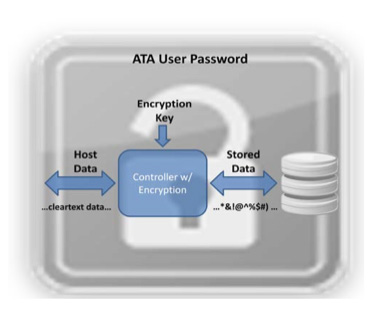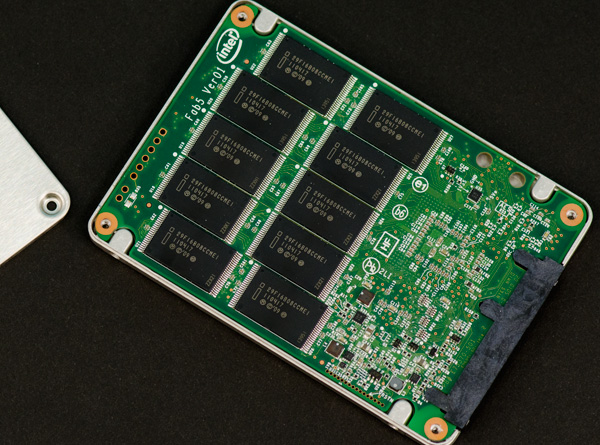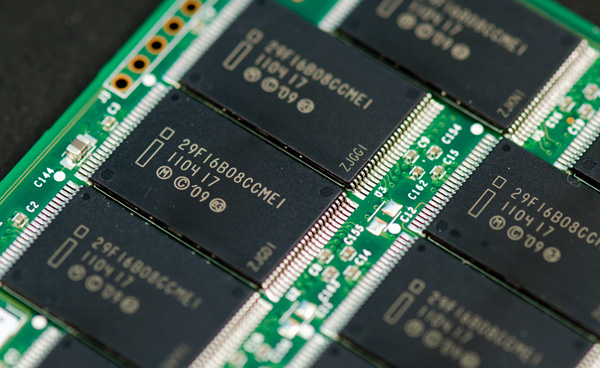The Intel SSD 320 Review: 25nm G3 is Finally Here
by Anand Lal Shimpi on March 28, 2011 11:08 AM EST- Posted in
- IT Computing
- Storage
- SSDs
- Intel
- Intel SSD 320
Spare Area and Redundant NAND
Intel's controller is a 10-channel architecture and thus drive capacities are still a little wonky compared to the competition. Thanks to 25nm NAND we now have some larger capacities to talk about: 300GB and 600GB.
Intel sent a 300GB version of the 320 for us to take a look at. Internally the drive has 20 physical NAND devices. Each NAND device is 16GB in size and features two 64Gbit 25nm 2-bit MLC NAND die. That works out to be 320GB of NAND for a drive whose rated capacity is 300GB. In Windows you'll see ~279GB of free space, which leaves 12.8% of the total NAND capacity as spare area.
Around half of that spare area is used to keep write amplification low and for wear leveling, both typical uses of spare area. The other half is for surplus NAND arrays, a RAID-like redundancy that Intel is introducing with the SSD 320.
As SandForce realized in the development of its controller, smaller geometry NAND is more prone to failure. We've seen this with the hefty reduction in rated program/erase cycles since the introduction of 50nm NAND. As a result, wear leveling algorithms are very important. With higher densities however comes the risk of huge amounts of data loss should there be a failure in a single NAND die. SandForce combats the problem by striping parity data across all of the NAND in the SSD array, allowing the recovery of up to a full NAND die should a failure take place. Intel's surplus NAND arrays work in a similar manner.
Instead of striping parity data across all NAND devices in the drive, Intel creates a RAID-4 style system. Parity bits for each write are generated and stored in the remaining half of the spare area in the SSD 320's NAND array. There's more than a full NAND die (~20GB on the 300GB drive) worth of parity data on the 320 so it can actually deal with a failure of more than a single 64Gbit (8GB) die.
Sequential Write Cap Gone, but no 6Gbps
The one thing that plagued Intel's X25-M was its limited sequential write performance. While we could make an exception for the G1, near the end of the G2's reign as most-recommended-drive the 100MB/s max sequential write speed started being a burden(especially as competing drives caught up and surpassed its random performance). The 320 fixes that by increasing rated sequential write speed to as high as 220MB/s.
You may remember that with the move to 25nm Intel also increased page size from 4KB to 8KB. On the 320, Intel gives credit to the 8KB page size as a big part of what helped it overcome its sequential write speed limitations. With twice as much data coming in per page read it's possible to have a fully page based mapping system and still increase sequential throughput.
Given that the controller hasn't changed since 2009, the 320 doesn't support 6Gbps SATA. We'll see this limitation manifest itself as a significantly reduced sequential read/write speed in the benchmark section later.
AES-128 Encryption
SandForce introduced full disk encryption starting in 2010 with its SF-1200/SF-1500 controllers. On SandForce drives all data written to NAND is stored in an encrypted form. This encryption only protects you if someone manages to desolder the NAND from your SSD and probes it directly. If you want your drive to remain for your eyes only you'll need to set an ATA password, which on PCs is forced by setting a BIOS password. Do this on a SandForce drive and try to move it to another machine and you'll be faced with an unreadable drive. Your data is already encrypted at line speed and it's only accessible via the ATA password you set.

Intel's SSD 320 enables a similar encryption engine. By default all writes the controller commits to NAND are encrypted using AES-128. The encryption process happens in realtime and doesn't pose a bottleneck to the SSD's performance.
The 320 ships with a 128-bit AES key from the factory, however a new key is randomly generated every time you secure erase the drive. To further secure the drive the BIOS/ATA password method I described above works as well.
A side effect of having all data encrypted on the NAND is that secure erases happen much quicker. You can secure erase a SF drive in under 3 seconds as the controller just throws away the encryption key and generates a new one. Intel's SSD 320 takes a bit longer but it's still very quick at roughly 30 seconds to complete a secure erase on a 300GB drive. Intel is likely also just deleting the encryption key and generating a new one. Without the encryption key, the data stored in the NAND array is meaningless.
The Test
| CPU |
Intel Core i7 965 running at 3.2GHz (Turbo & EIST Disabled) Intel Core i7 2600K running at 3.4GHz (Turbo & EIST Disabled) - for AT SB 2011, AS SSD & ATTO |
| Motherboard: |
Intel DX58SO (Intel X58) Intel H67 Motherboard |
| Chipset: |
Intel X58 + Marvell SATA 6Gbps PCIe Intel H67 |
| Chipset Drivers: |
Intel 9.1.1.1015 + Intel IMSM 8.9 Intel 9.1.1.1015 + Intel RST 10.2 |
| Memory: | Qimonda DDR3-1333 4 x 1GB (7-7-7-20) |
| Video Card: | eVGA GeForce GTX 285 |
| Video Drivers: | NVIDIA ForceWare 190.38 64-bit |
| Desktop Resolution: | 1920 x 1200 |
| OS: | Windows 7 x64 |













194 Comments
View All Comments
etamin - Monday, March 28, 2011 - link
This is probably a noob question for many of you but can someone explain to me why having a 6gbps controller/interface would increase performance if the drive itself maxes out at 240MB/s sequential read speed (128KB)? isn't 3gbps equal to 384MB/s? If the Intel 320 cannot saturate the SATA 3gbps bandwidth, what good would a 6gpbs bandwidth do for it? similarly, why do a lot of disk drives today have 6gbps interfaces when they can barely saturate 1/3 of a 3gbps interface? Thanks.nonzenze - Monday, March 28, 2011 - link
Because the controller can burst higher if data is handy in a cache.etamin - Tuesday, March 29, 2011 - link
I see. Is there a measure for burst speeds and I'm assuming this only applies to read operations?UNHchabo - Monday, March 28, 2011 - link
SATA uses 8b/10b encoding in all current revisions. This means that the theoretical limit for SATA 3Gb/s is 300MB/s.etamin - Tuesday, March 29, 2011 - link
very interesting, I'll be sure to keep that possibility in mind before converting other standards next time.Chloiber - Tuesday, March 29, 2011 - link
As you can clearly see with SATA3 SSDs running at SATA2, it's way lower.etamin - Thursday, March 31, 2011 - link
yes, that is obvious. I asked because I want to understand the architectural reason behind it.Nentor - Monday, March 28, 2011 - link
They are all so close to each other an unscrupulous HD manufacturer could use them to show there is barely any difference between a SSD and a HD.Why add keep adding them to the SSD articles?
etamin - Monday, March 28, 2011 - link
I think having HDDs in these articles sets a good baseline for those of us who don't already own ssds. Personally I'd actually like to see more hdds like 5400rpm notebook drives since many of these SSDs will be going into notebooks.wvh - Monday, March 28, 2011 - link
What exactly do I need to have encryption support? I've never noticed a SATA password option in my BIOS. Do most laptops support this?Lackluster as the performance seems to be, encryption support and increased reliability – while not sexy – are important, too. If not the enthusiast market, the corporate world might have more interest in such drives.